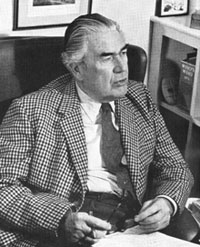E. W. Swanton
This article has multiple issues. Please help improve it or discuss these issues on the talk page. (Learn how and when to remove these template messages)
|
 | |||||||||||||||
| Personal information | |||||||||||||||
|---|---|---|---|---|---|---|---|---|---|---|---|---|---|---|---|
| Full name | Ernest William Swanton | ||||||||||||||
| Born | 11 February 1907 Forest Hill, London, England | ||||||||||||||
| Died | 22 January 2000 (aged 92) Canterbury, Kent, England | ||||||||||||||
| Nickname | Jim | ||||||||||||||
| Height | 6 ft 0 in (1.83 m) | ||||||||||||||
| Batting | Right-handed | ||||||||||||||
| Bowling | Right arm leg spin | ||||||||||||||
| Relations | Reymond de Montmorency (father-in-law) | ||||||||||||||
| Domestic team information | |||||||||||||||
| Years | Team | ||||||||||||||
| 1937–1938 | Middlesex | ||||||||||||||
| Career statistics | |||||||||||||||
| |||||||||||||||
Source: Cricinfo, 15 August 2022 | |||||||||||||||
Ernest William "Jim" Swanton
Early life
Swanton was born in Forest Hill in south London, the only son and eldest of three children of William Swanton, a stockbroker, and Lillian Emily, daughter of a German merchant who, on marriage to an Englishwoman, changed his name from Wolters to Walters.[1][2] He was a large baby and known as Jim, a diminutive of "Jumbo", from his earliest years. His father was treasurer of Forest Hill cricket club, and Swanton claimed that, whilst still a baby in his pram, he attended a cricket match at which W. G. Grace, then aged 59, scored a century for London County against Forest Hill.
He was educated at Brightlands prep school (later part of Dulwich College Preparatory School) and Cranleigh School. He did not excel at school academically or in sport, and decided to become a journalist on leaving school.
Pre-war journalism
Swanton started at the
Swanton formed his own cricket club in 1935, the Arabs, a nomadic club with no home ground. He also played three county cricket matches for Middlesex County Cricket Club in 1937 and 1938, all against university sides. He did not distinguish himself, scoring only 67 runs in five first-class innings. He was also president of Sandwich Town Cricket Club; he is labelled as having served the role for "25 years from 1976", although he died in January 2000.
H. S. Altham had written A History of Cricket, covering the period up until 1914. At Altham's invitation, Swanton continued the book to cover the period from the outbreak of World War I onwards. This extended edition was first published in 1938. For a revised edition in 1947 it was split into two volumes, the first by Altham and the second by Swanton. There were further updated editions in 1948 and 1962.
Second World War
Swanton served in the
Post-war career
He became cricket correspondent for The Daily Telegraph in 1946, remaining in that post until 1975. He was also editorial director of The Cricketer from 1967 to 1988. He toured Australia as a cricket correspondent seven times between 1946 and 1975, but never visited Pakistan to report on cricket, only reported on one Test match in India, and refused to visit South Africa from 1964 as a protest against apartheid. His writing style was very spare and simple, reporting what happened and why, without the flourishes of Neville Cardus or John Arlott. John Warr once described it as being "halfway between the Ten Commandments and Enid Blyton". His radio commentary provided a contrast to the romanticism of Arlott.
Essentially a traditionalist, he regretted the passing of the
He was awarded the
He made his selections as one of the voters for the
.His obituaries were fulsome, with Ted Dexter in The Sunday Telegraph saying "He was the standard by which other cricket commentators were judged". He helped Tony Greig in Greig's early cricketing career in England.
Personal life
Swanton married Ann Marion Carbutt in February 1958. She was daughter of
Swanton's wartime experience led him to a deep
Bibliography
- Elusive Victory (1951)
- Cricket and the Clock (1952)
- Best Cricket Stories (1953)
- West Indian Adventure 1953–1954 (1954)
- West Indies Revisited – MCC tour 1959–1960 (1960)
- A History of Cricket, Volume 2 (1962)
- Cricket from All Angles (1968)
- Sort of a Cricket Person (1972)
- Swanton in Australia with MCC 1946–1975 (1975)
- Follow On (1977)
- Barclays World of Cricket (General Editor) (1980 – 2nd ed.)
- As I Said at the Time – a Lifetime of Cricket (1983)
- Gubby Allen – Man of Cricket (1985)
- Kent Cricket – a Photographic History 1744–1984 (with C. H. Taylor) (1985)
- The Essential E. W. Swanton – the 1980s Observed (1990)
- Last Over – A Life in Cricket (1996)
- Cricketers of My Time (1999)
Further reading
- Jim: The Life of E. W. Swanton (2004) by ISBN 978-1-85410-900-2
References
- required.)
- ^ Arlott, Swanton and the Soul of English Cricket, Stephen Fay and David Kynaston, Bloomsbury, 2018, p. 2
- ^ "Cricket under the Japs". ESPNcricinfo. Retrieved 14 January 2021.
External links
- E. W. Swanton at ESPNcricinfo
- Cricket pundit Swanton dies (BBC News, 22 January 2000)
